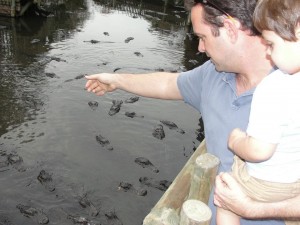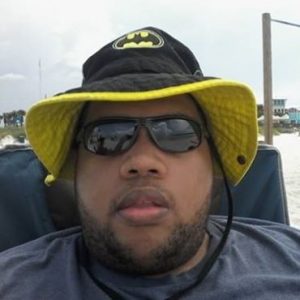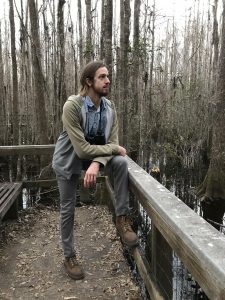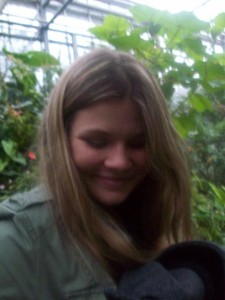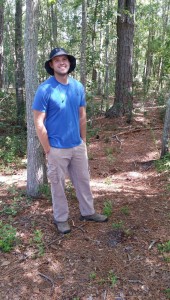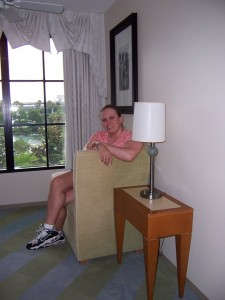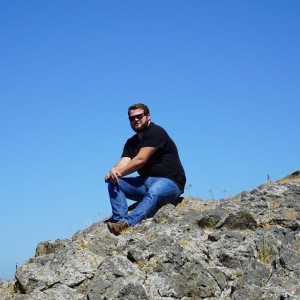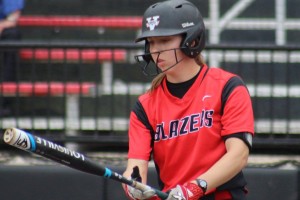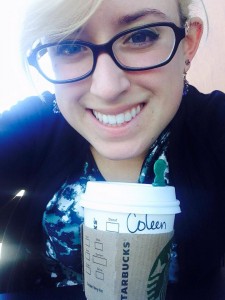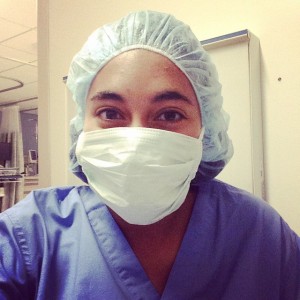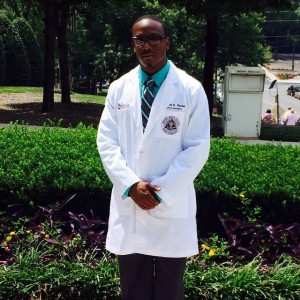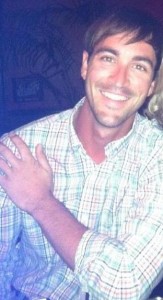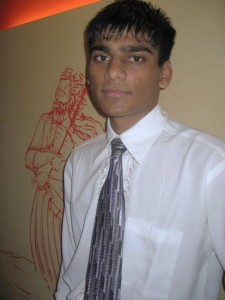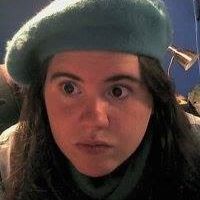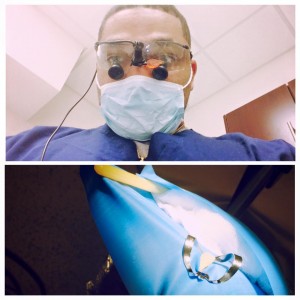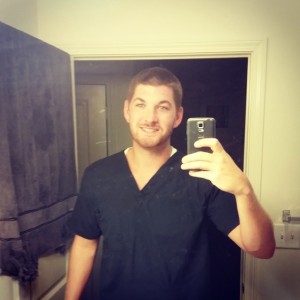Principal investigator
Corey Devin Anderson
- Dr. Anderson was born in Los Angeles and raised in San Diego. He earned his B.A. in Integrative Biology at UC Berkeley and his Ph.D. in Evolution, Ecology, and Population Biology at Washington University in St. Louis in 2006, where he was a student of Alan Templeton. He then spent five years as a post-doctoral researcher in Michael Rosenberg’s lab at the Biodesign Institute and School of Life Science at Arizona State University before accepting a professorship in the Department of Biology at Valdosta State University (in fall 2011). Dr. Anderson has been active in ecological research since 1995, where he started as an laboratory assistant in the College of Natural Resources at UC Berkeley. Dr. Anderson has a strong interest in the application of spatial data analysis and geospatial technology, and teaches courses on ecology, evolution, biostatistics, and spatial data analysis.
Masters of Science students
Current:
Josh Brown
- Spanish moss can reproduce sexually by seed or asexually by vegetative breakage. However, the relative frequency of different modes of reproduction cannot be easily determined because genets cannot be identified visually. Hence, we don’t know how much of the Spanish moss on the tree is due to colonization by seeds versus how much is associated with vegetative breakage.
- Hypervariable DNA-based markers could easily address this question, but have never been developed for Spanish moss. Josh is finishing some work that he started as an undergraduate, where explored the utility of cross species transference of microsatellite DNA primer sets developed for other bromeliads to Spanish moss. For his thesis, Josh is genotyping some of these loci and working on an empirical review on population genetic studies of epiphytes.
Blake Lamb
- Blake joined the Anderson lab in spring 2019. Blake is using an array of game cameras to examine the presence of other species at armadillo and gopher tortoise burrows, at sites where armadillos and gopher tortoises co-occur in the same forest. We want to compare the types of critters that use each type of burrow, and we want to explore how the intensity of burrowing in an area may affect capture patterns.
Former graduate students:
Brandi Missouri Griffin
- Brandi’s thesis (in collaboration with the Goddard and Uyeno labs) examined the functional morphology of strand breakage in Spanish moss. She found that older nodes are stronger and that nodes with flowers are weaker. She developed new techniques for imaging the anatomical structure of Spanish moss nodes, fully characterizing the tissue structures associated with node breakage.
Loren Binns
Loren joined the Anderson lab (via the Croteau/Elder labs). Her recently completed work on the spatial genetics of the nine-banded armadillo (at the Yazoo National Wildlife Refuge) found differences in spatial genetic structure between different sex/age subgroups, including novel evidence of positive spatial genetic autocorrelation in male armadillos (that was not present in adult females).

Undergraduate research
The Anderson Lab has been blessed with many excellent undergraduate assistants. Most of the undergrads in the lab have worked on genotyping armadillos and various aspects of the Spanish moss project. Many of the students that have worked in my lab have been amazingly successful after graduating from VSU, and watching them fulfill their dreams (often in the medical profession) has been one of the great pleasures of my job in Valdosta, GA
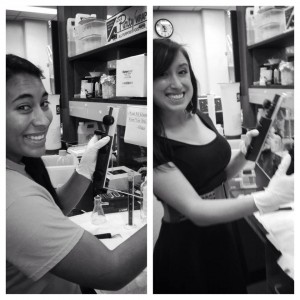
Anderson Lab legends Bianca Farley and Colleen Bradley showing off their bubble-free polyacrylamide gels.
Former laboratory assistants and directed study (Biology 4950) students:
Nia Keyes and Abigail Schwartz
- Nia and Abi are a dynamic duo that assisted with the Spanish moss study at Lake Louise (and will be co-authors on the forthcoming paper). Abigail is attending PA school at Georgia Regents University. Nia is a Ph.D. in medical entomology at the University of Georgia in Fall 2018. Nia and Abi are two of the hardest working students I have had and always had a great attitude in the field. I am very appreciative of their contribution to the lab.
Lyle Sellers
- Lyle did a directed study in the summer of 2015 and mainly assisted with field work for the burrow project at Moody Air Force Base. Lyle was one of the best field assistants I have ever had.
Officer Tracy M. Haddix
- Tracy (or “Officer Haddix”) is employed by the Valdosta Police Department and recently finished her BS in biology at VSU. She joined the Anderson Lab to get experience with DNA fingerprinting techniques. She mainly worked on scoring microsatellite DNA data for the armadillo project.
William Austin Haney (see Pantheon)
- Austin came to the Anderson Lab with an interest in molecular genetic techniques and, among other tasks, did most of the genotyping work for the grasshopper sparrow project. Austin did his MS in the Uyeno Lab at VSU and is now a Ph.D. student at Oregon State University.
Fran Johnson (see Pantheon)
- Fran came to the Anderson Lab to work on armadillos and leprosy. Fran recently finished PA school at South University.
Colleen Bradley
- Colleen came to the Anderson Lab to assist the armadillo project; she recently finish PA school at Mercer University.
Bianca Farley (see Pantheon)
- Bianca finished her MD at the Morehouse School of Medicine. Bianca came to the Anderson Lab wanting to work on snakes, but ended-up working on both the Spanish moss and nine-banded armadillo studies.
Nicholas Rouse
- Last I heard, Nick was enrolled in the DDS program at Meharry Medical College. Nick did a directed study in the Anderson Lab (in Spring 2013) and did some additional volunteer work in Summer 2013. Nick helped Dr. Anderson evaluate the feasibility of sampling the Florida Water Snake and also assisted in developing the field sampling methods for the Spanish moss project.
Ken Lowrey
- Ken did a survey of the epiphyte literature.
Vishal Kumar Patel
- Vishal did a directed study during the summer in the Anderson Lab. He extracted hundreds of armadillo genomes for the Anderson Lab. Vishal is doing a master’s degree in public health (MPH)…and then wants to follow that up with an MBA.
Anastasia Nienow
- Anastasia was a continuing student from Georgia Tech with a degree in Geosciences. She did some GIS mapping projects and assisted Dr. Anderson with some of work on cross-wavelet analysis.
David Jenkins
- David finished his DDS at Georgia Regents University and is now practicing with Eastmen Dental Associates. David helped with the Armadillo population genetic study in Spring 2013.
Aaron “Cole” Ford
- Cole helped to figure out how to get DNA out of old Armadillo ear clips (which are tough as leather). Cole finished his RN and NP and is now working the Panama City Beach area.

